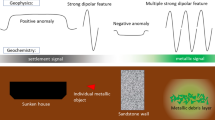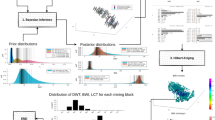Abstract
Classical geostatistical methods face serious computational challenges if they are confronted with large spatial datasets. The stochastic local interaction (SLI) approach does not require matrix inversion for parameter estimation, spatial prediction, and uncertainty estimation. This leads to better scaling of computational complexity and storage requirements with data size than standard (i.e., without size-reducing modifications) kriging. This contribution presents a simplified SLI model that can handle large data. The SLI method constructs a spatial interaction matrix (precision matrix) that adjusts with minimal user input to the data values, their locations, and sampling density variations. The precision matrix involves compact kernel functions which permit the use of sparse matrix methods. It is proved that the precision matrix of the proposed SLI model is strictly positive definite. In addition, parameter estimation based on likelihood maximization is formulated, and computationally relevant properties of the likelihood function are studied. The interpolation performance of the SLI method is investigated and compared with ordinary kriging using (i) synthetic non-Gaussian data and (ii) coal thickness measurements from approximately 11,500 drill holes (Campbell County, Wyoming, USA).














Similar content being viewed by others
References
Arlot S, Celisse A (2010) A survey of cross-validation procedures for model selection. Stat Surv 4:40–79
Armstrong M (1998) Basic linear geostatistics. Springer, Berlin
Armstrong M, Dowd PA (2013) Geostatistical simulations: proceedings of the geostatistical simulation workshop, Fontainebleau, France, 27–28 May 1993, volume 7 of quantitative geology and geostatistics. Springer, Dordrecht
Benndorf J, Dimitrakopoulos R (2018) New efficient methods for conditional simulations of large orebodies. In: Dimitrakopoulos R (ed) Advances in applied strategic mine planning. Springer, Cham, pp 353–370
Chilès JP, Delfiner P (2012) Geostatistics: modeling spatial uncertainty, 2nd edn. Wiley, New York
Chorti A, Hristopulos DT (2008) Non-parametric identification of anisotropic (elliptic) correlations in spatially distributed data sets. IEEE T Signal Process 56(10):4738–4751
Christakos G (1992) Random field models in earth sciences. Academic Press, San Diego
Cole SR, Chu H, Greenland S (2014) Maximum likelihood, profile likelihood, and penalized likelihood: a primer. Am J Epidemiol 179(2):252–260
Cressie N (1993) Spatial statistics. Wiley, New York
Cressie N, Hawkins M (1980) Robust estimation of the variogram: I. Math Geol 12(2):115–25
Cressie N, Johannesson G (2008) Fixed rank kriging for very large spatial data sets. J Roy Stat Soc B 70(1):209–226
Dowd PA, Dare-Bryan PC (2007) Planning, designing and optimising production using geostatistical simulation. In: Dimitrakopoulos R (ed) Orebody modelling and strategic mine planning, Carlton, Victoria, Australia: The Australasian Institute of Mining and Metallurgy, Spectrum Series, 2nd edn, pp 363–378
Ellis MS (2002) Quality of economically extractable coal beds in the Gillette coal field as compared with other tertiary coal beds in the Powder River Basin, Wyoming and Montana. Technical Report No. 2002-174, U.S. Geological Survey
Ellis MS, Flores RM, Ochs AM, Stricker GD, Gunther GL, Rossi GS, Bader LR, Schuenemeyer JH, Power HC (1999) Gillette coalfield, powder river basin: geology, coal quality, and coal resources. Technical report, U.S. Geological Survey Professional Paper 1625-A, Chapter PG
Furrer R, Genton MG, Nychka D (2006) Covariance tapering for interpolation of large spatial datasets. J Comput Graph Stat 15(3):502–523
Goovaerts P (1997) Geostatistics for natural resources evaluation. Oxford University Press, New York
Heaton MJ, Datta A, Finley AO, Furrer R, Guinness J, Guhaniyogi R, Gerber F, Gramacy RB, Hammerling D, Katzfuss M, Lindgren F (2019) A case study competition among methods for analyzing large spatial data. J Agric Biol Environm Stat 24(3):398–425
Hristopulos DT (2003) Spartan Gibbs random field models for geostatistical applications. SIAM I Sci Comput 24(6):2125–2162
Hristopulos DT, Elogne S (2007) Analytical properties and covariance functions for a new class of generalized Gibbs random fields. IEEE Trans Inform Theory 53(12):4667–4679
Hristopulos DT (2002) New anisotropic covariance models and estimation of anisotropic parameters based on the covariance tensor identity. Stoch Env Res Risk A 16(1):43–62
Hristopulos DT (2015a) Covariance functions motivated by spatial random field models with local interactions. Stoch Env Res Risk A 29(3):739–754
Hristopulos DT (2015b) Stochastic local interaction (SLI) model: bridging machine learning and geostatistics. Comput Geosci 85(Part B):26–37
Hristopulos DT (2020) Random fields for spatial data modeling: a primer for scientists and engineers. Springer, Dordrecht
Hristopulos DT, Agou VD (2019) Stochastic local interaction model with sparse precision matrix for space-time interpolation. Spat Stat-Neth:100403
Journel AG (1974) Geostatistics for conditional simulation of ore bodies. Econ Geol 69(5):673–687
Journel AG (2005) Beyond covariance: the advent of multiple-point geostatistics. In Leuangthong O, Deutsch CV (eds) Geostatistics Banff 2004, volume 14 of quantitative geology and geostatistics. Springer, Dordrecht, pp 225–233
Journel AG, Huijbregts CJ (1978) Mining geostatistics. Academic Press, London
Journel AG, Kyriakidis PC (2004) Evaluation of mineral reserves: a simulation approach. Oxford University Press, Oxford
Krige DG (1951) A statistical approach to some basic mine valuation problems on the Witwatersrand. J S Afr I Min Metall 52(6):119–139
Lantuéjoul C (2002) Geostatistical simulation: models and algorithms. Springer, Berlin
Lasinio GJ, Mastrantonio G, Pollice A (2013) Discussing the “big n problem’’. Stat Method Appl 22(1):97–112
Lindgren F, Rue H, Lindström J (2011) An explicit link between Gaussian fields and Gaussian Markov random fields: the SPDE approach. J Roy Stat Soc B Met 73(4):423–498
Mardia KV, Marshall RJ (1984) Maximum likelihood estimation of models for residual covariance in spatial regression. Biometrika 71(1):135–146
Mariethoz G, Caers J (2015) Multiple-point geostatistics: stochastic modeling with training images. Wiley, Chichester
Matheron G (1963) Principles of geostatistics. Econ Geol 58(8):1246–1266
Minniakhmetov I, Dimitrakopoulos R (2017) Joint high-order simulation of spatially correlated variables using high-order spatial statistics. Math Geosci 49(1):39–66
Murphy SA, Van der Vaart AW (2000) On profile likelihood. J Am Stat Assoc 95(450):449–465
Mussardo G (2010) Statistical field theory. Oxford University Press, Oxford
Nadaraya EA (1964) On estimating regression. Theor Probab Appl 9(1):141–142
Nocedal J, Wright S (2006) Numerical optimization, 2nd edn. Springer, New York
Olea RA (2012) Geostatistics for engineers and earth scientists. Springer, New York
Rasmussen CE, Williams CKI (2006) Gaussian processes for machine learning. MIT Press, Cambridge
Rivoirard J (1987) Two key parameters when choosing the kriging neighborhood. Math Geol 19(8):851–856
Rue H, Held L (2005) Gaussian Markov random fields: theory and applications. Chapman and Hall, Boca Raton
Severini TA, Wong WH (1992) Profile likelihood and conditionally parametric models. Ann Stat 20(4):1768–1802
Strebelle SB, Journel AG (2001) Reservoir modeling using multiple-point statistics. In: SPE annual technical conference and exhibition, 30 September–3 October, New Orleans, Louisiana, Society of Petroleum Engineers, SPE–71324–MS
Sun Y, Li B, Genton MG (2012) Geostatistics for large datasets. In: Porcu E, Montero J, Schlather M (eds) Advances and challenges in space-time modelling of natural events. Lecture notes in statistics. Springer, Berlin, pp 55–77
Wackernagel H (2003) Multivariate geostatistics. Springer, Berlin
Watson GS (1964) Smooth regression analysis. Sankhya Ser A 26(1):359–372
Zhong X, Kealy A, Duckham M (2016) Stream kriging: incremental and recursive ordinary kriging over spatiotemporal data streams. Comput Geosci 90:134–143
Acknowledgements
The authors would like to thank Ricardo Olea (United States Geological Survey, Reston, Virginia, USA) who provided the coal data analyzed and graciously read a draft of this manuscript, offering valuable comments and insights.
Author information
Authors and Affiliations
Corresponding author
Supplementary Information
Below is the link to the electronic supplementary material.
Rights and permissions
About this article
Cite this article
Hristopulos, D.T., Pavlides, A., Agou, V.D. et al. Stochastic Local Interaction Model: An Alternative to Kriging for Massive Datasets. Math Geosci 53, 1907–1949 (2021). https://doi.org/10.1007/s11004-021-09957-7
Received:
Accepted:
Published:
Issue Date:
DOI: https://doi.org/10.1007/s11004-021-09957-7




